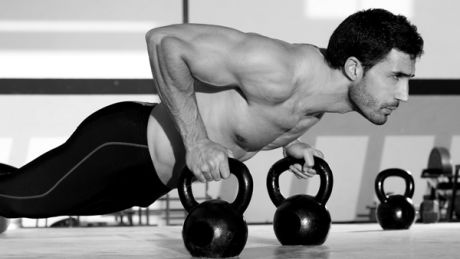How To Train On Any Budget
Not having much spare cash shouldn’t stop you from training. Here’s how to get in phenomenal shape whatever your budget

There are many ways you can approach getting in shape, and a variety of factors to consider when choosing which method is best for you. And let’s be honest, a key factor for most of us is how much we are willing to spend. Before reaching for your wallet, check out our detailed guide to training budgets below.
£0 PER MONTH
Not being able to afford a gym membership shouldn’t stop you from getting in shape. With a bit of imagination you can devise perfectly good workouts to perform in the comfort of your own home – without using any expensive kit.
What you get ‘Training at home gets you thinking and encourages you to be creative with your workouts,’ says elite strength and conditioning coach Andy McKenzie. ‘You can use bodyweight moves to build power, improve conditioning and boost your cardio, all by playing around with set and rep ranges, tempos and rest periods.’
The pros
- It’s cheap, obviously.
- It’s much more convenient than going to the gym, which makes it easier to motivate yourself.
The cons
- It can be hard to replicate the effects of low-rep, heavy lifting at home.
- It can be tricky to work your back and shoulders with bodyweight moves.
UP TO £60 PER MONTH
This budget will allow you to afford a gym membership at most high-street gym chains.
What you get ‘We offer a range of facilities for members to enjoy,’ says Steve Dick of Virgin Active Heath Clubs. ‘This includes anything from the gym floor – including all the latest fitness innovations – to studio classes, Power Plate (which many gyms charge extra for), indoor and outdoor swimming pools, spas and beauty salons, children’s facilities and crèches, racquet sports and lounge areas. All our staff from lifeguards to club general managers receive significant and appropriate training to ensure that you get an enjoyable experience in a safe environment.’
The pros
- You can enjoy a huge range of training and additional facilities, and there are plenty of other members who are all potential training partners.
- A monthly membership is affordable for most people.
The cons
- Not all gyms will be equipped with kit that suits your needs – for example, it’s worth checking if the weights area has a squat rack.
- Gyms can get busy during peak hours – lunchtimes and early evenings – which might hamper your workouts if you can’t get your hands on the kit you need.
UP TO £300 PER MONTH
Expanding your budget to this level means you can afford a high-street gym membership and twice-weekly sessions with a personal trainer.
What you get ‘A standard gym membership at Pure will give you access to a variety of equipment, facilities and resources 24 hours a day, seven days a week to help you achieve your fitness goals,’ says Graeme Penny, Midlands regional manager for Pure Gyms. ‘Sessions with a personal trainer can offer different benefits depending on your needs. Some people want access to the technical knowledge a PT can provide to help them get specific results. Others need a high level of support from day one.’
The pros
Get the Coach Newsletter
Sign up for workout ideas, training advice, reviews of the latest gear and more.
- In addition to a gym membership, you have a qualified trainer to help tailor your sessions, monitor your progress and correct your form to ensure you don’t get injured.
The cons
- You’ll have to decide if this justifies the significant increase in cost.
- If you struggle to motivate yourself, one session per week with a personal trainer might not be enough to keep your training on track.
UP TO £1,050 PER MONTH
What you get ‘I run my business on a six-weekly scheme,’ says David Fletcher of The Odyssey Way. ‘After carrying out a thorough initial assessment with a client, I provide them with a specific six-week programme that includes two personal training sessions a week with me, a nutrition plan to follow and “homework” in the form of exercise routines for them to do separately to complement the sessions we do together. I like to think of it as an all-encompassing approach to achieving fat loss results.’
The pros
- You get to train in a quiet gym with a fully tailored, in-depth training plan and easy access to all the kit you need.
- The PTs are likely to be better qualified than those at a high-street gym chain.
The cons
- You’re spending a lot of money but still spending half your time at a regular gym.
UNLIMITED BUDGET
If money’s no object, you can get fully personalised training and nutritional support around the clock.
What you get ‘Our clients come to us with a wide range of goals, including weight loss, specific event training and injury rehabilitation,’ says Stephen Price, founder of SP&Co. ‘Our philosophy is about total health, and about identifying and addressing the underlying issues in order to deliver genuine and long-lasting improvement. Every client is assessed across a series of criteria covering all aspects of health, lifestyle and fitness. A detailed and unique programme is devised for each individual that provides the perfect range of therapies and activities specific to their needs. It’s a dedicated intimate and focused services delivered in the most exclusive fashion.’
The pros
- It’s about as comprehensive an approach to fitness as you could possibly imagine.
The cons
- It’s very expensive – SP&Co’s service costs £1,350 a month.
